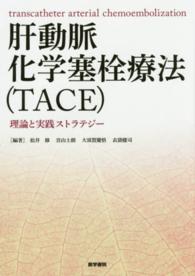- ホーム
- > 洋書
- > 英文書
- > Science / Mathematics
Full Description
Table 1. State variables modeled in MOSES. State variable Units Estuaries are characterized by a strong diversity in car- bon sources. This is because of the existence of an 3 Fast-decay detritus g- intertidal habitat, the supply of nutrients and organic 3 Slow-decay detritus g- material from the river and from the sea and the input of 3 gCm- Freshwater diatoms matter from human origin. If turbidity remains limited, 3 Freshwater flagellates g- estuaries can also support a high primary production 3 Brackish and marine diatoms g- as nutrients are abundant. Nevertheless, estuaries are 3 Cm- Brackish and marine flagellates usually heterotrophic ecosystems (Billen et aI. , 1991; 3 gCm- Micro-zooplankton Smith & Hollibaugh, 1993) where respiratory process- 3 Brackish meso-zooplankton gCm- 3 es exceed in situ production. Marine meso-zooplankton gCm- 2 3 gCm- The Westerschelde estuary (260 km in SAWES, Hyperbenthos 3 gSim- Detrital silicate 1991) drains about 21580 square kilometres ofland in 3 gSim- Dissolved silicate one of the most densely populated and highly industri- 3 gNm- Nitrate and nitrite alised regions of Europe (Wollast, 1988).
This estuary 3 gNm- Ammonia is unusual due to the high degree of eutrophication 3 gOm- Oxygen which results from the discharge of untreated wastes 3 gCl m- Chlorides (Heip, 1988) and due to the high residence time of the 3 gm- Suspended matter water masses (Soetaert & Herman, 1995a).
Contents
Major biological processes in European tidal estuaries: a synthesis of the JEEP-92 Project.- Primary production.- Nutrients, light and primary production by phytoplankton and microphytobenthos in the eutrophic, turbid Westerschelde estuary (The Netherlands).- Dynamics and distribution of microphytobenthic chlorophyll-a in the Western Scheldt estuary (SW Netherlands).- Bacterial processes.- Comparison of heterotrophic bacterial production rates in early spring in the turbid estuaries of the Scheldt and the Elbe.- Nitrous oxide emissions from estuarine intertidal sediments.- Carbon and nitrogen cycling in intertidal sediments near Doel, Scheldt Estuary.- Zooplankton.- Copepod feeding in the Westerschelde and the Gironde.- Long-term changes in the population of Eurytemora affinis (Copopoda, Calanoida) in the Gironde estuary (1978-1992).- Secondary production of the brackish copepod communities and their contribution to the carbon fluxes in the Westerschelde estuary (The Netherlands).- Feeding rates and productivity of the copepod Acartia bifilosa in a highly turbid estuary; the Gironde (SW France).- Production rates of Eurytemora affinis in the Elbe estuary, comparison of field and enclosure production estimates.- Comparative spring distribution of zooplankton in three macrotidal European estuaries.- Hyperbenthos.- Comparative study of the hyperbenthos of three European estuaries.- Meiobenthos.- Effects of manipulation of food supply on estuarine meiobenthos.- Meiobenthic distribution and nematode community structure in five European estuaries.- Macrobenthos.- The response of two estuarine benthic communities to the quantity and quality of food.- Modelling.- Estimating estuarine residence times in the Westerschelde (The Netherlands) using a box model with fixeddispersion coefficients.- Nitrogen dynamics in the Westerschelde estuary (SW Netherlands) estimated by means of the ecosystem model MOSES.- Carbon flows in the Westerschelde estuary (The Netherlands) evaluated by means of an ecosystem model (MOSES).








